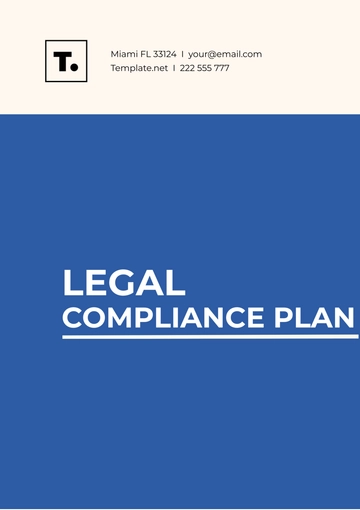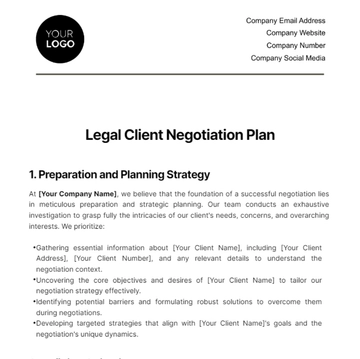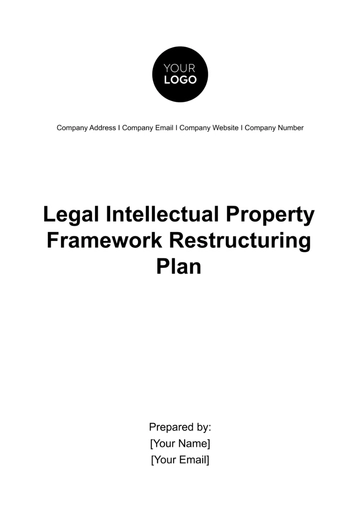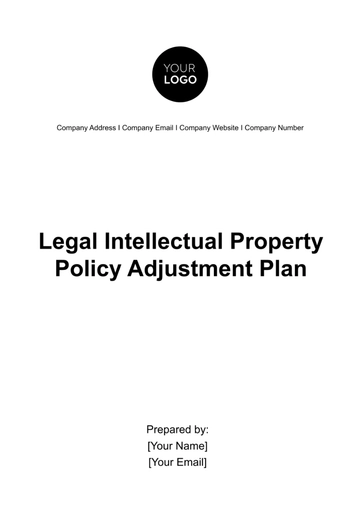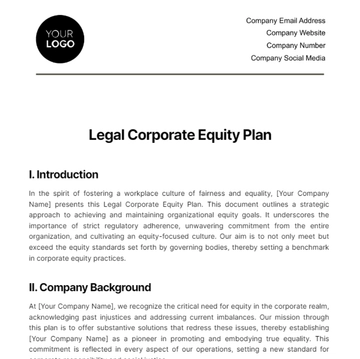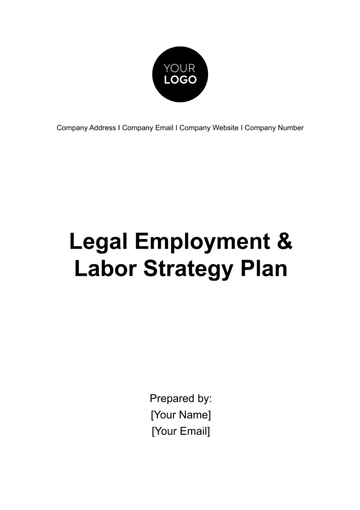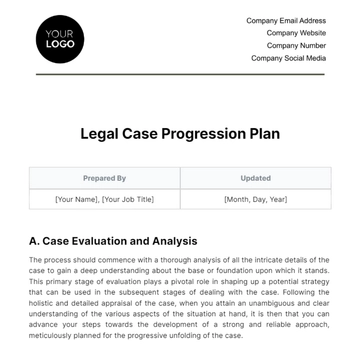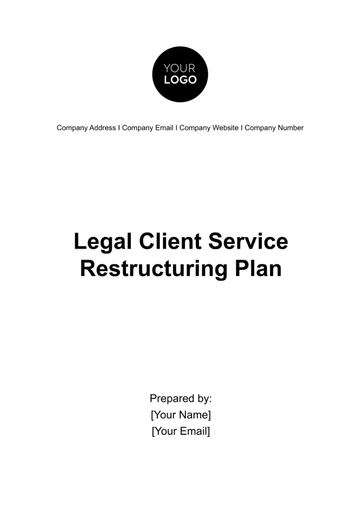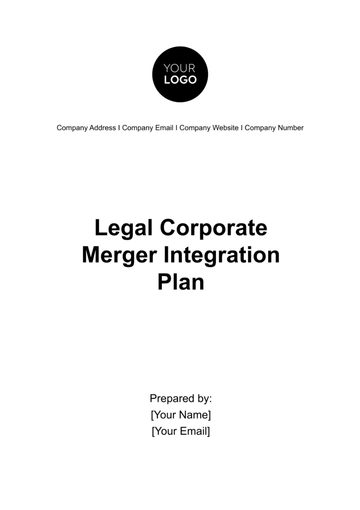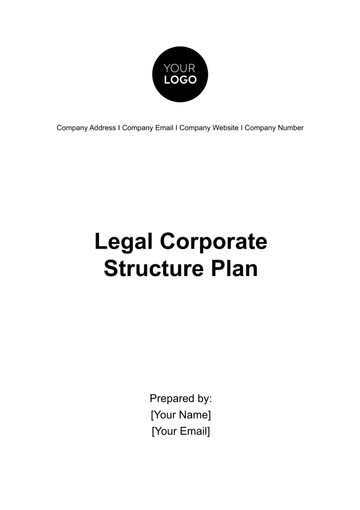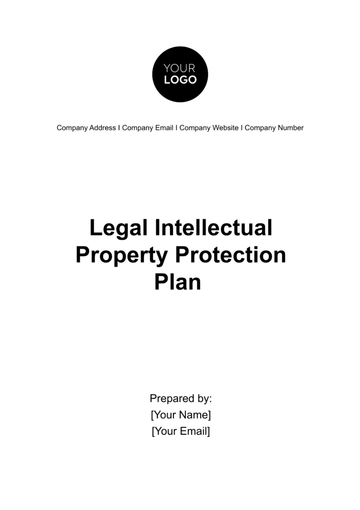Free Legal Intellectual Property Protection Plan

A. Introduction and Objectives
In the rapidly changing landscape of the global business environment, safeguarding intellectual property (IP) assets is paramount for [Your Company Name]. This Legal Intellectual Property Protection Plan is crafted with the prime objective of securing our proprietary technologies, ensuring the safety of our brand identity, and nurturing innovation within our ranks. It lays down a strategic framework designed to deter unauthorized use and infringement of our intellectual creations, thereby solidifying our position in the market and enhancing our competitive edge.
Recognizing the intrinsic value of our intellectual assets, we are committed to implementing robust protection mechanisms. This plan not only aims to defend our existing IP but also to foster an environment where new ideas and innovations can flourish without fear of misappropriation. Through vigilant monitoring, rigorous enforcement, and continuous education on IP rights and responsibilities, we seek to build a culture of respect for intellectual property that aligns with our core values and business goals.
B. Inventory of Intellectual Property Assets
To effectively manage and protect our intellectual assets, [Your Company Name] has meticulously cataloged our key intellectual property (IP) assets. Below is a streamlined inventory that outlines the variety and status of our patents, trademarks, copyrights, trade secrets, domain names, and other critical forms of IP integral to our operations and strategic goals.
IP Asset Type | Description/Status |
|---|---|
Patents | Technology patents for [Your Product/Technology], Registered/Pending |
Trademarks | Brand names, logos, and slogans, Registered/Pending |
Copyrights | Software code, website content, marketing materials, Registered |
Trade Secrets | Proprietary algorithms, customer lists, Protected internally |
Domain Names | [Your Company Website], Registered |
Other Forms of IP | Design patents, utility models, Registered/Pending |
C. IP Ownership and Authorship
We have clearly defined the ownership rights and authorship for all our intellectual property assets. This is important for determining how our IP can be used, licensed, or sold. It also provides clarity in case of disputes over IP rights.
D. Assessment of IP Protection Status
Ensuring clarity and legal standing on IP ownership and authorship is critical for [Your Company Name]. This clarity serves multiple purposes: it delineates how our intellectual property can be utilized, licensed, or monetized, and provides a clear path for resolution in the event of disputes over IP rights. Below are three key subsections that elaborate on our approach to IP ownership and authorship:
Employee and Contractor Creations: All intellectual property created by employees in the course of their employment, or by contractors as specified in their contracts, is owned by [Your Company Name]. We maintain comprehensive agreements to secure rights to inventions, designs, and works produced.
Joint Ventures and Partnerships: For IP developed through collaborations, ownership and authorship are clearly outlined in partnership agreements. These documents specify the rights of each party and the distribution of benefits derived from jointly created intellectual property.
Licensing and Third-Party Use: We establish clear terms for the licensing of our IP assets, ensuring that all usage by third parties is authorized and in alignment with our strategic interests. This includes detailed provisions for authorship credit and financial compensation where applicable.
E. Protection Strategies
We have devised specific strategies for those IP assets that are not yet protected or could benefit from better protection. Measures like applying for patents, registering trademarks, or implementing confidentiality agreements are a few actions planned as mentioned below:
Apply for patents
Register trademarks
Implement confidentiality agreements
Set up non-disclosure agreements
Restrict access to sensitive information
F. Monitoring and Enforcement
[Your Company Name]'s commitment to protecting our intellectual property extends to rigorous monitoring and enforcement strategies. These strategies are designed to identify unauthorized use or infringements and to take decisive action to uphold our IP rights. Our approach encompasses four key areas:
Regular IP Audits: Conducting periodic audits to ensure our IP is not being used without authorization across digital and physical domains.
Online Surveillance: Utilizing advanced software tools to scan the internet, including websites, social media platforms, and online marketplaces, for unauthorized use of our IP.
Cease and Desist Notices: Issuing cease and desist letters as an initial step to address infringement, aiming to halt unauthorized use before escalating to legal action.
Legal Action: When necessary, pursuing litigation to enforce our IP rights, working with legal counsel to take appropriate steps against infringers, including seeking injunctions and damages.
G. IP Licensing and Commercialization
[Your Company Name] has established comprehensive guidelines for the licensing and commercialization of our intellectual property, aimed at maximizing the value derived from our IP assets. This strategic approach not only facilitates revenue generation but also enhances our brand's visibility and market presence. Our framework is divided into three pivotal areas:
Licensing Agreements: We detail the process for negotiating licenses, including setting terms for usage, royalties, and duration. Our agreements are tailored to protect our interests while providing value to licensees.
Commercialization Strategies: Our plan outlines methods for turning IP into profitable ventures, whether through product development, partnerships, or other avenues. We assess market needs and opportunities to ensure our IP is leveraged effectively.
IP Valuation and Royalties: Establishing the value of our IP is crucial for setting appropriate royalty rates. We employ industry-standard methods to accurately assess the worth of our intellectual assets, ensuring fair compensation for their use.
H. Handling IP Infringements
To safeguard the integrity of our intellectual assets, [Your Company Name] has established a meticulous procedure for addressing intellectual property (IP) infringements. Swift and decisive action is essential to protect our rights and prevent further unauthorized use. Our procedure ensures that we respond effectively, preserving the value and security of our IP portfolio. The following four-step process is implemented upon identifying potential IP infringements:

I. Education and Awareness
[Your Company Name] recognizes the critical role that awareness and education play in the protection of our intellectual property (IP). By empowering our employees with knowledge and best practices, we strengthen our collective ability to safeguard our valuable IP assets. Our education and awareness initiatives are designed to instill a culture of respect and responsibility towards IP within our organization. These efforts are organized into two key areas:
IP Protection Training: We provide comprehensive training sessions for all employees, covering the basics of intellectual property rights, the importance of protecting IP, and the specific roles individuals play in this process. Training includes case studies, scenarios, and practical advice on avoiding common pitfalls that could lead to unauthorized use or exposure.
Best Practices and Guidelines: Employees are equipped with clear guidelines and best practices for handling confidential and proprietary information. This includes secure communication protocols, proper documentation of creative and development processes, and steps to take when they suspect or identify potential IP infringements.
J. Review and Update Mechanism
At [Your Company Name], we understand that the landscape of intellectual property (IP) and the business environment are ever-evolving. To ensure that our Legal Intellectual Property Protection Plan remains effective and aligned with these changes, we have instituted a robust review and update mechanism. This process involves periodic assessments of our IP strategy in light of new legislative developments, shifts in the market, technological advancements, and any modifications within our own IP portfolio.
This mechanism is designed to be proactive and comprehensive, involving stakeholders from various departments such as legal, R&D, and business strategy. Reviews are scheduled on a regular basis and also triggered by significant events that could impact our IP position. By maintaining this dynamic approach, [Your Company Name] ensures that our IP protection efforts are always current, adequately safeguarding our assets against new threats and capitalizing on emerging opportunities. This adaptability is crucial for sustaining our competitive advantage and fostering innovation.
- 100% Customizable, free editor
- Access 1 Million+ Templates, photo’s & graphics
- Download or share as a template
- Click and replace photos, graphics, text, backgrounds
- Resize, crop, AI write & more
- Access advanced editor
Safeguard your innovations with the Legal Intellectual Property Protection Plan Template from Template.net. This editable and customizable template is designed to assist in developing a robust strategy for protecting your intellectual property (IP). Tailored to be editable in our Ai Editor Tool, it offers a detailed approach to identifying, securing, and managing your IP assets, ensuring your creative and business endeavors are well-protected against infringement.
You may also like
- Finance Plan
- Construction Plan
- Sales Plan
- Development Plan
- Career Plan
- Budget Plan
- HR Plan
- Education Plan
- Transition Plan
- Work Plan
- Training Plan
- Communication Plan
- Operation Plan
- Health And Safety Plan
- Strategy Plan
- Professional Development Plan
- Advertising Plan
- Risk Management Plan
- Restaurant Plan
- School Plan
- Nursing Home Patient Care Plan
- Nursing Care Plan
- Plan Event
- Startup Plan
- Social Media Plan
- Staffing Plan
- Annual Plan
- Content Plan
- Payment Plan
- Implementation Plan
- Hotel Plan
- Workout Plan
- Accounting Plan
- Campaign Plan
- Essay Plan
- 30 60 90 Day Plan
- Research Plan
- Recruitment Plan
- 90 Day Plan
- Quarterly Plan
- Emergency Plan
- 5 Year Plan
- Gym Plan
- Personal Plan
- IT and Software Plan
- Treatment Plan
- Real Estate Plan
- Law Firm Plan
- Healthcare Plan
- Improvement Plan
- Media Plan
- 5 Year Business Plan
- Learning Plan
- Marketing Campaign Plan
- Travel Agency Plan
- Cleaning Services Plan
- Interior Design Plan
- Performance Plan
- PR Plan
- Birth Plan
- Life Plan
- SEO Plan
- Disaster Recovery Plan
- Continuity Plan
- Launch Plan
- Legal Plan
- Behavior Plan
- Performance Improvement Plan
- Salon Plan
- Security Plan
- Security Management Plan
- Employee Development Plan
- Quality Plan
- Service Improvement Plan
- Growth Plan
- Incident Response Plan
- Basketball Plan
- Emergency Action Plan
- Product Launch Plan
- Spa Plan
- Employee Training Plan
- Data Analysis Plan
- Employee Action Plan
- Territory Plan
- Audit Plan
- Classroom Plan
- Activity Plan
- Parenting Plan
- Care Plan
- Project Execution Plan
- Exercise Plan
- Internship Plan
- Software Development Plan
- Continuous Improvement Plan
- Leave Plan
- 90 Day Sales Plan
- Advertising Agency Plan
- Employee Transition Plan
- Smart Action Plan
- Workplace Safety Plan
- Behavior Change Plan
- Contingency Plan
- Continuity of Operations Plan
- Health Plan
- Quality Control Plan
- Self Plan
- Sports Development Plan
- Change Management Plan
- Ecommerce Plan
- Personal Financial Plan
- Process Improvement Plan
- 30-60-90 Day Sales Plan
- Crisis Management Plan
- Engagement Plan
- Execution Plan
- Pandemic Plan
- Quality Assurance Plan
- Service Continuity Plan
- Agile Project Plan
- Fundraising Plan
- Job Transition Plan
- Asset Maintenance Plan
- Maintenance Plan
- Software Test Plan
- Staff Training and Development Plan
- 3 Year Plan
- Brand Activation Plan
- Release Plan
- Resource Plan
- Risk Mitigation Plan
- Teacher Plan
- 30 60 90 Day Plan for New Manager
- Food Safety Plan
- Food Truck Plan
- Hiring Plan
- Quality Management Plan
- Wellness Plan
- Behavior Intervention Plan
- Bonus Plan
- Investment Plan
- Maternity Leave Plan
- Pandemic Response Plan
- Succession Planning
- Coaching Plan
- Configuration Management Plan
- Remote Work Plan
- Self Care Plan
- Teaching Plan
- 100-Day Plan
- HACCP Plan
- Student Plan
- Sustainability Plan
- 30 60 90 Day Plan for Interview
- Access Plan
- Site Specific Safety Plan


